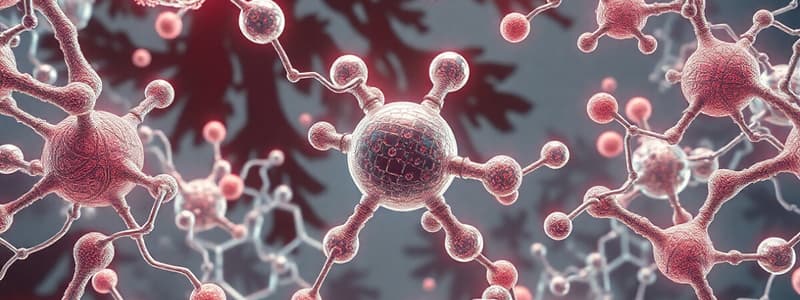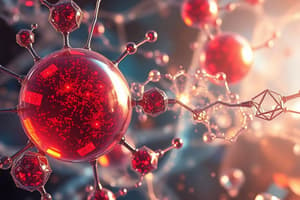Podcast
Questions and Answers
London Dispersion forces are less important for larger molecules in predicting physical properties.
London Dispersion forces are less important for larger molecules in predicting physical properties.
False (B)
Molecules containing –OH or –NH groups exhibit strong intermolecular attractions.
Molecules containing –OH or –NH groups exhibit strong intermolecular attractions.
True (A)
The binding site on a macromolecule is where a drug interacts with the molecule.
The binding site on a macromolecule is where a drug interacts with the molecule.
True (A)
Reversible binding of drugs occurs without the need for an equilibrium state.
Reversible binding of drugs occurs without the need for an equilibrium state.
All drug interactions with proteins are permanent and involve covalent bonding.
All drug interactions with proteins are permanent and involve covalent bonding.
Receptors are usually soluble proteins found in high abundance within the body.
Receptors are usually soluble proteins found in high abundance within the body.
The central nervous system (CNS) uses a polarization-depolarization mechanism for signal transmission.
The central nervous system (CNS) uses a polarization-depolarization mechanism for signal transmission.
Protein interactions with drugs are insignificant due to their size.
Protein interactions with drugs are insignificant due to their size.
Binding interactions must be strong enough to hold the messenger sufficiently long for signal transduction to take place.
Binding interactions must be strong enough to hold the messenger sufficiently long for signal transduction to take place.
Covalent bonds are the most common type of bond involved in drug-receptor interactions.
Covalent bonds are the most common type of bond involved in drug-receptor interactions.
The dissociation constant of the drug-receptor complex indicates the potency of the drug.
The dissociation constant of the drug-receptor complex indicates the potency of the drug.
Chemical messengers undergo a chemical reaction when binding to their receptors.
Chemical messengers undergo a chemical reaction when binding to their receptors.
Ionic bonds are stronger than covalent bonds in drug-receptor interactions.
Ionic bonds are stronger than covalent bonds in drug-receptor interactions.
The binding site of a receptor is similar to the active site of an enzyme.
The binding site of a receptor is similar to the active site of an enzyme.
Ligand receptor interactions involve types of bonds that are the same as drug-enzyme interactions.
Ligand receptor interactions involve types of bonds that are the same as drug-enzyme interactions.
Nucleophiles in biology include amino acids like serine and cysteine.
Nucleophiles in biology include amino acids like serine and cysteine.
Ion-dipole interactions are stronger than dipole-dipole interactions.
Ion-dipole interactions are stronger than dipole-dipole interactions.
H-bonds occur only between uncharged compounds.
H-bonds occur only between uncharged compounds.
P-hydroxybenzoate has less potent antibacterial action compared to methyl salicylate.
P-hydroxybenzoate has less potent antibacterial action compared to methyl salicylate.
Intramolecular H-bonding occurs between two nearby molecules.
Intramolecular H-bonding occurs between two nearby molecules.
Electron donors can include alkenes, alkynes, and aromatic rings bearing electron donating groups.
Electron donors can include alkenes, alkynes, and aromatic rings bearing electron donating groups.
The stability of H-bonds is measured between -1 to -7 Kcal/mol.
The stability of H-bonds is measured between -1 to -7 Kcal/mol.
Carboxylate groups can act as better H-bond acceptors than anions.
Carboxylate groups can act as better H-bond acceptors than anions.
Charge-transfer interactions occur between an electron donor in one molecule and an electron acceptor in the same molecule.
Charge-transfer interactions occur between an electron donor in one molecule and an electron acceptor in the same molecule.
Cysteine acts as an electron acceptor.
Cysteine acts as an electron acceptor.
Hydrophobic interactions lead to an increase in entropy.
Hydrophobic interactions lead to an increase in entropy.
Van der Waals forces are the strongest type of intermolecular bond.
Van der Waals forces are the strongest type of intermolecular bond.
An agonist can mimic the natural messenger of a receptor.
An agonist can mimic the natural messenger of a receptor.
Hydrophobic interactions only occur between polar molecules.
Hydrophobic interactions only occur between polar molecules.
The stability of van der Waals interactions contributes significantly to the strength of drug-receptor binding.
The stability of van der Waals interactions contributes significantly to the strength of drug-receptor binding.
Lacosamide interacts with the receptor through π-π interactions.
Lacosamide interacts with the receptor through π-π interactions.
To design an agonist, the chemical structure of the normal substrate is not necessary.
To design an agonist, the chemical structure of the normal substrate is not necessary.
A drug must have the correct shape and size to fit the binding site.
A drug must have the correct shape and size to fit the binding site.
Allosteric antagonists bind to the same site as the agonist.
Allosteric antagonists bind to the same site as the agonist.
Affinity refers to the maximum biological effect a drug can produce.
Affinity refers to the maximum biological effect a drug can produce.
Potency is defined as the amount of drug needed for a defined biological effect.
Potency is defined as the amount of drug needed for a defined biological effect.
The 'umbrella' effect involves a drug covering the opening of the binding site.
The 'umbrella' effect involves a drug covering the opening of the binding site.
Non-competitive antagonists can still allow the agonist to achieve a maximal response.
Non-competitive antagonists can still allow the agonist to achieve a maximal response.
A compound with high affinity always has high efficacy.
A compound with high affinity always has high efficacy.
Potency does not depend on the affinity of the receptor for binding the drug.
Potency does not depend on the affinity of the receptor for binding the drug.
Flashcards are hidden until you start studying
Study Notes
### Intermolecular Forces
- London Dispersion forces become more important for larger molecules.
- Hydrogen bonding is present in molecules containing -OH or -NH groups, as well as HF molecules.
The Body's Systems
- The nervous system (CNS) includes the sympathetic and parasympathetic nervous systems and uses polarization-depolarization signals.
- The liver is responsible for detoxification and storage.
- Understanding hormones requires an understanding of the molecular level of body organization.
Drug Targets
- Macromolecules such as proteins, lipids, carbohydrates, and nucleic acids are common drug targets.
- Drug action occurs through binding to these molecules.
- The binding site is a specific region on a macromolecule where the interaction occurs.
- Drug-target interactions can be permanent (irreversible) through covalent bonding or reversible through other types of interactions.
Binding Mechanisms
- Binding occurs through functional groups on a chemical compound.
- Functional groups utilize their electronic and shape characteristics for binding.
- Bonds can be intermolecular or intramolecular.
- Reversible binding involves an equilibrium between the drug and its target.
Receptor-Drug Interaction
- Receptors are often membrane-bound proteins that bind to ligands, triggering physiological responses.
- Receptors are difficult to isolate due to their small amounts and challenging purification.
- Signal transduction occurs through receptor binding, resulting in a biological response.
- The driving force for drug-receptor interaction is the low energy state of the complex.
- Biological activity is related to the drug's affinity for the receptor and the stability of the complex.
- The dissociation constant of the drug-receptor complex reflects the drug's potency.
Types of Bonds in Receptor-Drug Interaction
- Covalent bonds: Strong and irreversible, rare in drug-receptor interactions but more common in drug-enzyme and drug-DNA interactions.
- Nucleophiles in biological systems include thiol (cysteine), hydroxyl (serine), amine (lysine), and carboxylate (glutamic acid).
- Electrophiles include epoxide rings, alkyl groups bonded to halogens, and positively charged centers.
- Ionic or electrostatic interactions: Weaker than covalent bonds, prevalent in drug-receptor interaction.
- Opposite charges between drug and receptor molecules are required.
- Ionization and distance between charges influence bond strength.
- Examples include interactions between acidic amino acids (aspartic acid, glutamic acid) and basic amino acids (histidine, lysine, arginine).
- Ion-dipole and dipole-dipole interactions: Occur when ionic groups interact with permanent dipoles.
- Energy level is between -1 to -7 kcal/mol.
- Ion-dipole interactions are stronger than dipole-dipole interactions.
- Hydrogen bonding: Requires both a hydrogen bond donor (electron-deficient hydrogen) and acceptor (electron-rich atom).
- Bond strength is -1 to -7 kcal/mol.
- H-bonds are typically between 1.5-2.2 Å.
- Anions are better H-bond acceptors than uncharged compounds.
- Delocalized lone pairs on nitrogen weaken H-bond donor capacity.
- Two types: Intramolecular (within a molecule) and intermolecular (between molecules).
- Intramolecular H-bonding can influence pharmacological action.
- Charge-transfer interactions: Occur between electron donor and acceptor groups.
- Electron donors include alkenes, alkynes, aromatic rings with electron-donating groups, and atoms with non-bonded electron pairs (O, N, S).
- Electron acceptors include aromatic rings with electron-withdrawing groups.
- Examples include aromatic rings of tyrosine and carboxylate groups of aspartate (donors) and cysteine (acceptor).
- Hydrophobic interactions: Occur between nonpolar groups surrounded by ordered water molecules.
- Water molecules become disordered when nonpolar groups interact, increasing entropy and stabilizing the complex.
- This stabilization is called hydrophobic interaction.
- Examples include π-π interactions between aromatic rings in face-to-face arrangements.
- Van der Waals forces: Temporary dipole interactions due to non-symmetrical electron distribution.
- These bonds are weak with a stability of -0.5 kcal/mol.
Drug-Receptor Interactions Examples
- Dibucaine, a local anesthetic drug, exhibits various types of interactions.
Receptor Agonists and Antagonists
- Agonists: Mimic natural messengers, binding reversibly to the receptor and activating it.
- Antagonists: Block the action of natural messengers or agonists by binding to the receptor.
- Strategies for antagonist design:
- Designed to fit the binding site but fail to change the receptor's shape.
- Allosteric antagonists bind to different sites on the receptor.
- "Umbrella effect" antagonists bind near the binding site, preventing the messenger's access.
- Strategies for antagonist design:
Competitive vs. Non-Competitive Antagonists
- Competitive antagonists: Compete with agonists for receptor binding, reducing agonism and requiring higher agonist concentrations.
- Non-competitive antagonists: Bind to different sites on the receptor, either preventing agonist binding or the agonistic effect, reducing the maximum achievable response.
Affinity, Efficacy, and Potency
- Affinity: The strength of drug binding to the receptor.
- Efficacy: The maximum biological effect a drug can produce.
- Potency: The amount of drug needed to achieve a defined biological effect.
- High affinity does not guarantee high efficacy.
- Potency is influenced by affinity and the efficiency of coupling drug-receptor interactions to response.
Recommended Books
- The Organic Chemistry of Drug Design by Richard B. Silverman (2nd Edition)
- An Introduction to Medicinal Chemistry by Graham L. Patrick (4th Edition)
Studying That Suits You
Use AI to generate personalized quizzes and flashcards to suit your learning preferences.


